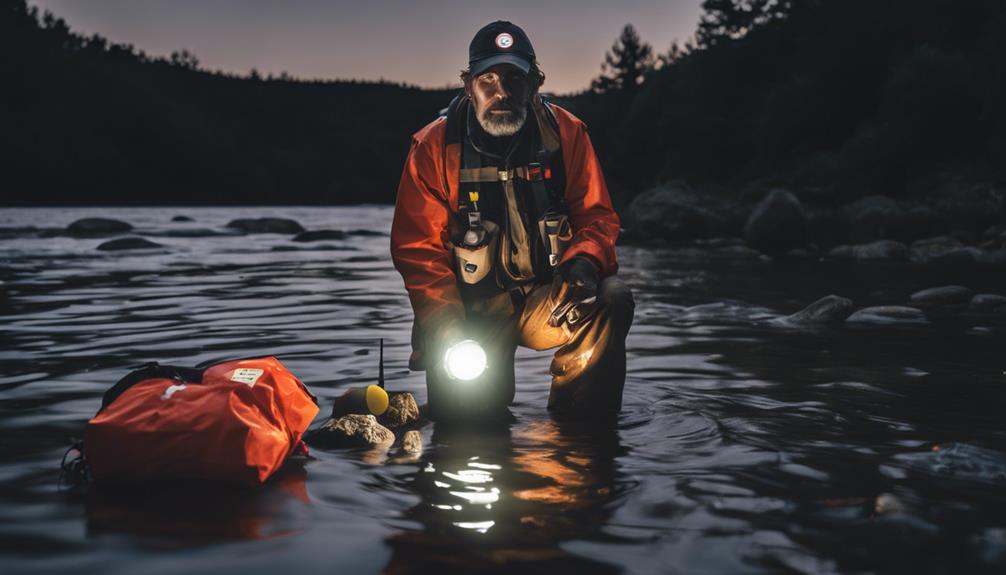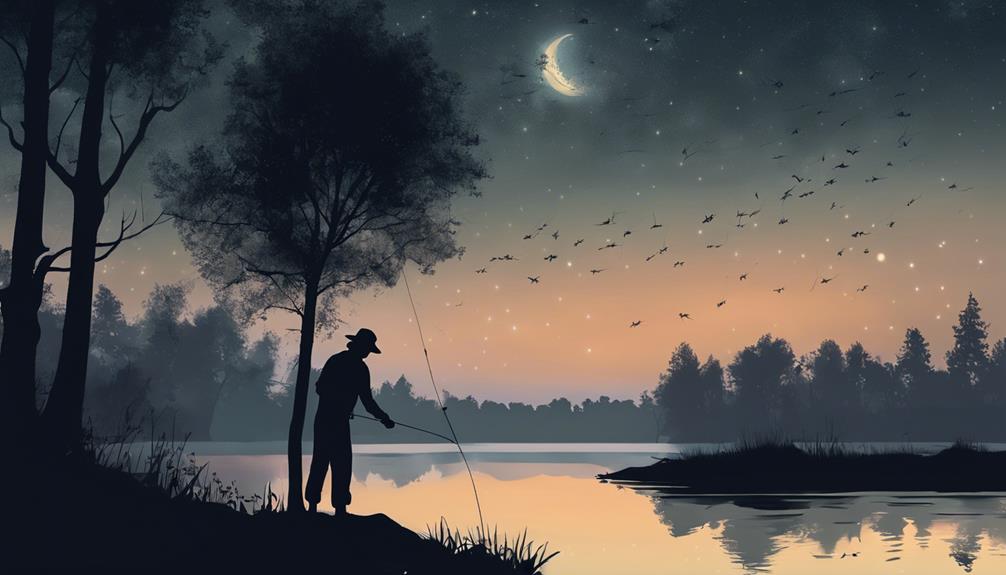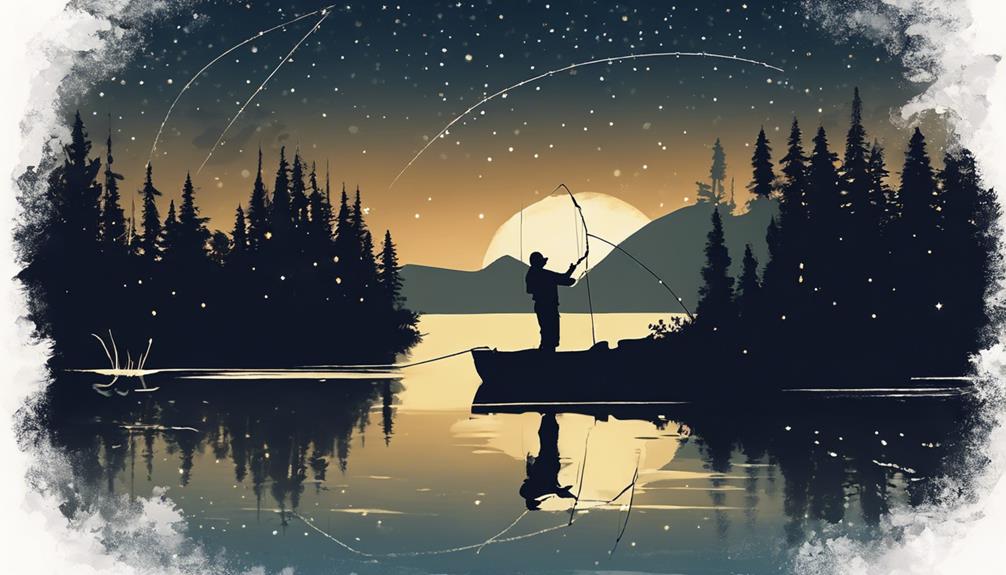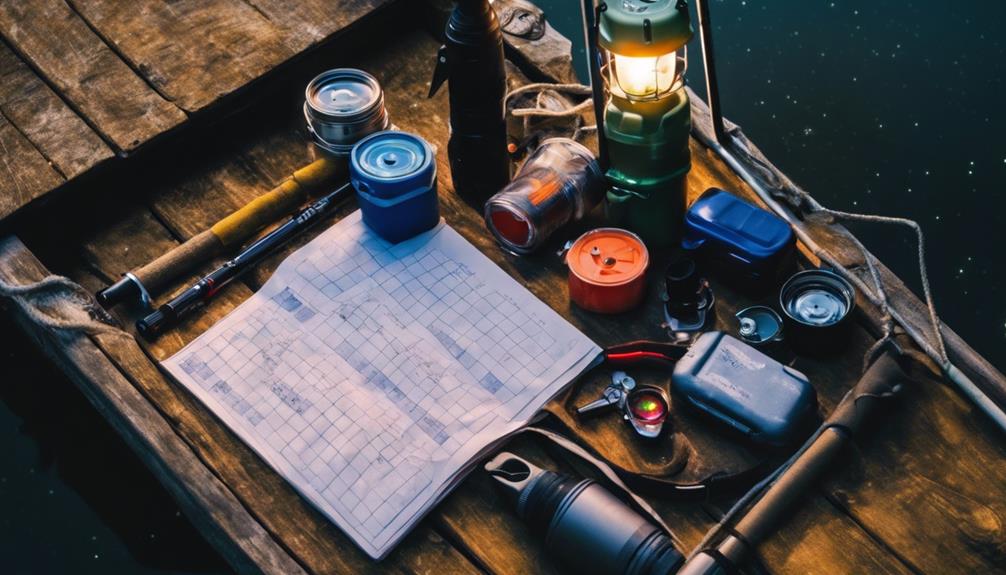Night fly fishing demands unique strategies as nocturnal fish behavior, specialized gear, and heightened sensory awareness in low-light conditions come into play. Understanding the nuances of fish activity influenced by moon phases and feeding habits is key. Selecting the right flies to mimic nocturnal prey enhances your chances of a successful catch. Proper lighting for visibility, mastering stealth with silent approaches, and utilizing senses other than sight are crucial. Safety measures like reflective clothing and emergency communication add to the experience. Dive deeper into the intricate world of night fly fishing to elevate your skills and successes.
Benefits of Night Fly Fishing
Engaging in night fly fishing can provide anglers with a unique opportunity to target elusive species that are more active during the nocturnal hours. The advantages of night fishing include reduced competition from other anglers, cooler temperatures for both the fish and the angler, and the chance to catch larger fish that come closer to the surface under the cover of darkness. However, night fishing also comes with its challenges, such as limited visibility, potential safety hazards, and the need for specialized gear and techniques to be successful.
To make the most of your night fly fishing experience, it's essential to have the right gear. Essential items include a reliable headlamp or flashlight to navigate in the dark, polarized sunglasses to improve visibility in low light conditions, and insect repellent to ward off pesky bugs that are more active at night. Additionally, using a heavier tippet and larger flies can help attract bigger fish that are more active during the night.
When night fishing, it's crucial to pay attention to your surroundings and take extra precautions. Always inform someone of your fishing plans and location, wear appropriate clothing for the weather conditions, and be aware of potential wildlife encounters. By being prepared and using the right gear and techniques, you can maximize your chances of success during your night fly fishing adventures.
Understanding Nocturnal Fish Behavior
Understanding the behavior of nocturnal fish is crucial for successful night fly fishing expeditions. Nocturnal fish exhibit unique patterns influenced by various factors such as moon phases, water temperature, and feeding behavior. During different moon phases, fish activity can vary significantly. For instance, during a full moon, some species may be more active and feed closer to the surface, while during a new moon, they might stay deeper and be less active. This lunar influence is essential to consider when planning a night fishing trip.
Water temperature also plays a vital role in shaping the behavior of nocturnal fish. As the temperature drops at night, fish may move to shallower areas where the water is warmer. Understanding these temperature fluctuations can help anglers target areas where fish are more likely to be actively feeding.
Feeding patterns of nocturnal fish are another critical aspect to consider. Some species are known to feed more aggressively at night, taking advantage of the cover of darkness to hunt for prey. Matching your fly patterns to mimic the nocturnal creatures these fish feed on can increase your chances of a successful catch.
Selecting the Right Flies for Night Fishing
Consider the diverse nocturnal feeding habits and environmental factors to effectively choose the appropriate flies for night fishing expeditions. When selecting flies for night fishing, it's crucial to take into account the moon phases and water temperature to increase your chances of a successful catch.
Moon phases play a significant role in nocturnal fishing as they affect the feeding behavior of fish. During a full moon, fish may be more active and visible near the water's surface, making them more receptive to flies that mimic surface-dwelling insects. In contrast, during a new moon, fish tend to stay deeper in the water, requiring flies that can reach those depths effectively.
Water temperature is another essential factor to consider when choosing flies for night fishing. As water temperature drops at night, fish metabolism slows down, making them less likely to chase fast-moving prey. Therefore, using flies that move more slowly and erratically can entice sluggish fish to strike.
Importance of Proper Lighting
Proper lighting is crucial for maximizing visibility and enhancing the effectiveness of your night fly fishing endeavors. When engaging in night fly fishing, utilizing proper illumination techniques is essential to ensure adequate nighttime vision. Moonlight can offer advantages as a natural light source, aiding in navigation and reducing the need for artificial lighting. However, in situations where moonlight is minimal, using a flashlight becomes necessary.
To make the most of moonlight, position yourself so that the moon is at your back. This positioning helps illuminate the water in front of you, allowing for better visibility of your surroundings. Additionally, adjusting your eyes to the darkness by avoiding bright lights can enhance your ability to see in low light conditions.
Flashlights are valuable tools for night fly fishing, but their use requires careful consideration. When using a flashlight, opt for red or green light instead of white light as it's less likely to startle fish. Red and green lights also preserve your night vision better. Furthermore, using a headlamp can be beneficial as it keeps your hands free for fishing tasks. Remember to keep your lighting subtle and strategic to avoid spooking the fish. By mastering the art of proper lighting, you can significantly improve your night fly fishing experience.
Mastering the Art of Stealth
To excel in night fly fishing, achieving a high level of stealth is essential for minimizing disturbances and increasing your chances of success. A silent approach is crucial when navigating the waters under the cover of darkness. The noise created by wading, casting, or even setting up equipment can easily spook fish in the quiet of the night. To maintain stealth, ensure your movements are deliberate and controlled. Take slow, measured steps, and avoid sudden splashes or disturbances in the water.
Light discipline is another key aspect of mastering the art of stealth in night fly fishing. Excessive light can't only alert fish to your presence but also disrupt their natural behavior. Use dim, preferably red lights to illuminate your immediate area without casting harsh glares that could scare away potential catches. When tying knots or changing flies, shield your light source to prevent it from shining directly onto the water. Additionally, be mindful of ambient light sources such as headlamps or flashlights carried by fellow anglers, as these can also affect the stealth of your approach.
Utilizing Senses Other Than Sight
Maximizing your ability to engage senses beyond vision can significantly enhance your effectiveness in night fly fishing. When fishing in the dark, sound navigation becomes crucial. The ability to listen attentively to the subtle nuances of the water can guide you towards potential feeding zones. By honing in on the distinct sounds of fish rising or insects skimming the surface, you can better pinpoint where to cast your line.
Sensory awareness is key in night fly fishing. Your sense of touch becomes heightened as you feel for the slightest tug on the line. Being attuned to these delicate movements can alert you to a fish taking the fly in the dark. Additionally, the sense of smell can play a role in attracting fish, as some fly patterns are designed to mimic scents that fish find irresistible.
Utilizing your senses other than sight also involves being mindful of your surroundings. The rustling of trees, the chirping of insects, and even the direction of the wind can all provide valuable information to help you succeed in night fly fishing. Developing a keen sensitivity to these sensory cues can make the difference between a frustrating night and a successful fishing expedition.
Safety Precautions When Night Fishing

Enhancing your safety during night fishing requires a meticulous approach to potential risks and the implementation of strategic measures to mitigate them effectively. When engaging in night fly fishing, ensuring personal well-being is paramount. One crucial safety precaution is to always inform someone of your fishing plans, including your expected return time. This is essential for emergency communication in case something goes awry.
Equipping yourself with a reliable communication device, such as a fully charged cell phone or a two-way radio, can be a lifesaver in emergencies. Additionally, carrying a whistle or a personal locator beacon is recommended for signaling distress if needed. It's imperative to have these emergency communication tools within reach at all times during night fishing.
Maintaining visibility is another key aspect of ensuring personal well-being during night fishing. Wearing reflective clothing or accessories can help others spot you in the dark, especially if you're near water. Furthermore, using a headlamp or a flashlight with a red light setting can aid in navigation and illuminate your surroundings without affecting your night vision.
Enhancing Your Night Fly Fishing Experience
Implementing strategic lighting techniques can significantly enhance your night fly fishing experience. When considering moon phases, it's crucial to plan your night fishing trips around the lunar calendar. Fishing during a full moon can provide ample natural light, making it easier to see your surroundings and potential catches. Conversely, during a new moon, the night is darker, requiring more artificial lighting for visibility.
Having the right equipment is essential for a successful night fly fishing experience. Utilize headlamps with red or green light settings to maintain your night vision while tying flies or navigating the waters. Additionally, fluorescent lines and indicators can help track your line movement in low-light conditions.
Weather conditions play a vital role in night fly fishing. Choose nights with stable weather patterns to ensure a more pleasant and productive outing. Windy nights can make casting difficult, while clear, calm nights offer optimal fishing conditions.
Selecting the right location is key to enhancing your night fly fishing experience. Look for areas with minimal light pollution to fully appreciate the night sky and increase your chances of spotting fish. Remote locations away from city lights provide a serene atmosphere for night fishing.
Frequently Asked Questions
What Are the Best Ways to Adjust to Fishing in the Dark?
To adjust to fishing in the dark, consider using night vision aids to enhance visibility. Understanding moon phases can help anticipate fish behavior.
Keep your movements slow and deliberate to avoid spooking fish. Choose flies that create noise or vibration to attract fish in low light conditions.
Practice casting techniques to improve accuracy in the dark. Stay aware of your surroundings for safety and optimal fishing success.
Are There Specific Dangers to Be Aware of While Night Fishing?
When night fishing, safety precautions must be a top priority to avoid potential dangers.
It's important to stay vigilant and aware of your surroundings, especially in areas with low visibility.
Wildlife encounters can be more likely during nighttime fishing excursions, so be prepared with appropriate gear and knowledge to handle any unexpected situations.
Always have a plan in place for emergencies and ensure you have proper lighting to stay safe while enjoying your night fishing experience.
How Can One Effectively Navigate a Fishing Spot in the Dark?
To effectively navigate a fishing spot in the dark, utilize lighting techniques for better visibility. Maintain a stealthy approach to avoid spooking fish.
Consider moon phases and their impact on fish feeding habits. Understanding these factors will help you strategically position yourself for a successful night fly fishing experience.
Is There a Certain Type of Gear That Is Essential for Night Fishing?
When night fishing, having the right gear is crucial. Essential items include:
- Lighting options for visibility
- Night vision gear for spotting fish in the dark
- Rod holders for easy access
Safety measures are also important, such as:
- Wearing reflective clothing
- Having a first aid kit on hand
What Are Some Common Mistakes to Avoid When Night Fly Fishing?
When night fly fishing, be cautious to avoid common mistakes. Ensure proper lighting for safety and visibility. Select the ideal fly and master your casting techniques.
Mistakes like using excessive force in casting, choosing the wrong fly, or neglecting safety precautions can hinder your success. Stay focused, adjust to the darkness, and remember to prioritize safety and precision in your night fly fishing endeavors.
Conclusion
In conclusion, night fly fishing requires unique strategies due to the nocturnal behavior of fish, the importance of selecting the right flies, proper lighting, mastering stealth, utilizing other senses, and safety precautions.
By understanding these factors and enhancing your skills, you can have a successful and enjoyable night fly fishing experience. Remember to always be prepared, stay alert, and adapt to the challenges of fishing in the dark for a rewarding adventure.



